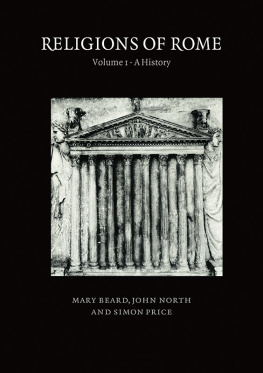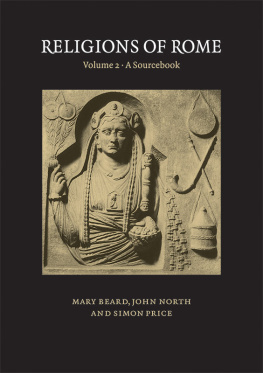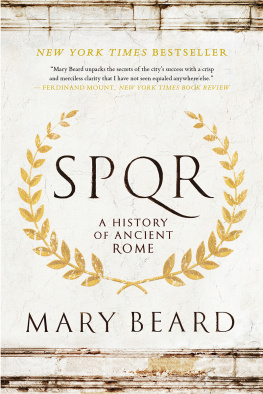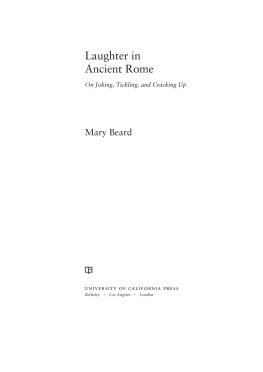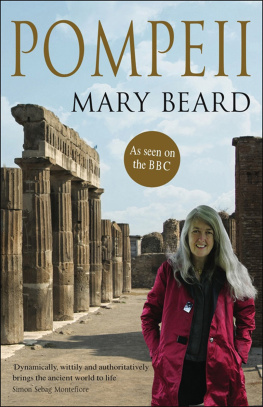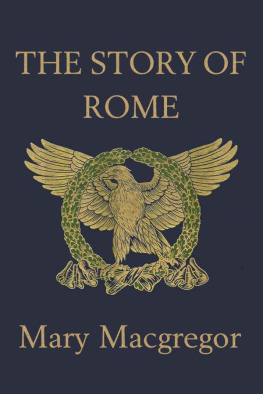Mary Beard and John North and Simon Price - Religions of Rome Volume 1 of 2
Here you can read online Mary Beard and John North and Simon Price - Religions of Rome Volume 1 of 2 full text of the book (entire story) in english for free. Download pdf and epub, get meaning, cover and reviews about this ebook. year: 1995, publisher: Cambridge University Press, genre: Religion. Description of the work, (preface) as well as reviews are available. Best literature library LitArk.com created for fans of good reading and offers a wide selection of genres:
Romance novel
Science fiction
Adventure
Detective
Science
History
Home and family
Prose
Art
Politics
Computer
Non-fiction
Religion
Business
Children
Humor
Choose a favorite category and find really read worthwhile books. Enjoy immersion in the world of imagination, feel the emotions of the characters or learn something new for yourself, make an fascinating discovery.
- Book:Religions of Rome Volume 1 of 2
- Author:
- Publisher:Cambridge University Press
- Genre:
- Year:1995
- Rating:4 / 5
- Favourites:Add to favourites
- Your mark:
- 80
- 1
- 2
- 3
- 4
- 5
Religions of Rome Volume 1 of 2: summary, description and annotation
We offer to read an annotation, description, summary or preface (depends on what the author of the book "Religions of Rome Volume 1 of 2" wrote himself). If you haven't found the necessary information about the book — write in the comments, we will try to find it.
Religions of Rome Volume 1 of 2 — read online for free the complete book (whole text) full work
Below is the text of the book, divided by pages. System saving the place of the last page read, allows you to conveniently read the book "Religions of Rome Volume 1 of 2" online for free, without having to search again every time where you left off. Put a bookmark, and you can go to the page where you finished reading at any time.
Font size:
Interval:
Bookmark:
This book offers a radical new survey of more than a thousand years of religious life at Rome: from the foundation of the city to its rise to world empire and its conversion to Christianity. Religion was central to Roman culture; it was part of the fabric of politics and warfare, imperial power and its opponents, domestic life and philosophical theorizing. This authoritative account sets religion in its full cultural context, whether in the primitive hamlet of the eighth century B.C. or the cosmopolitan, multicultural society of the first centuries of the Christian era.
The narrative account is structured around a series of broad themes: how to interpret the Romans own theories of their religious system and its origins; the relationship of religion and the changing politics of Rome; the religious importance of the layout and monuments of the city itself; changing ideas of religious identity and community; religious invasion -and, ultimately, revolution.
The companion volume, Religions of Rome 2: A Sourcebook, sets out a wide range of documents (including painting, coins, sculpture and inscriptions) richly illustrating the religious life of the Roman world.
Religions of Rome
Volume 1
A History
VOLUME 1
A History
MARY BEARD
Reader in Classics in the University of Cambridge, and Fellow of Newnham College
JOHN NORTH
Professor of History, University College London
SIMON PRICE
Fellow and Tutor, Lady Margaret Hall, Oxford

CAMBRIDGE UNIVERSITY PRESS
Cambridge, New York, Melbourne, Madrid, CapeTown, Singapore, So Paulo, Delhi, Mexico City
Cambridge University Press
The Edinburgh Building, Cambridge CB2 8RU, UK
Published in the United States of America by Cambridge University Press, New York
www.cambridge.org
Information on this title: www.cambridge.org/9780521304016
Mary Beard, John North and Simon Price 1998
This publication is in copyright. Subject to statutory exception and to the provisions of relevant collective licensing agreements, no reproduction of any part may take place without the written permission of Cambridge University Press.
First published 1998
14th printing 2013
Printed and bound in the United Kingdom by the MPG Books Group
A catalogue record for this publication is available from the British Library
ISBN 9780 5 213 16828 Paperback
Cambridge University Press has no responsibility for the persistence or accuracy of URLs for external or third-party internet websites referred to in this publication, and does not guarantee that any content on such websites is, or will remain, accurate or appropriate. Information regarding prices, travel timetables and other factual information given in this work are correct at the time of first printing but Cambridge University Press does not guarantee the accuracy of such information thereafter.
Many people have helped in different ways and at different points over the decade that we have been working on this volume and its companion. We would like to thank Andreas Bendlin, Robin Cormack, Michael Crawford, John Curran, Denis Feeney, Martin Goodman, Keith Hopkins, Christopher Kelly, David MacMullen, Lucia Nixon, Nicholas Purcell, Joyce Reynolds, Helen Weston, Greg Woolf; and staff in the Ashmolean Library, Oxford, the Classics Faculty and Library, Cambridge, the Institute of Classical Studies, London, as well as the Institute of Advanced Studies, Princeton, the Libraries of the British and American Schools in Athens and the Ward Chipman Library of the University of New Brunswick at Saint John.
In particular, we have used (and enjoyed) the comments of John Henderson, who read the whole manuscript; and are grateful for the care and patience of Pauline Hire, who finally extracted it from us.
Earlier versions of three chapters have already appeared in volumes of The Cambridge Ancient History 2nd edn ( by S. R. F. P. in x). Anyone who chooses to compare what is printed here with those earlier versions will see how profound the effects of collaboration have been.
M.B.
J. A. N.
S. R. F. P.
October 1996
In A.D. 495 (or thereabouts) the Bishop of Rome sent a stern letter to some of his fellow Christians in the city, denouncing those who continued to celebrate the ancient ritual of the Lupercalia. past), Bishop Gelasius was faced with the problem of an old pagan ritual that would not die. Many members of his flock watched eagerly, it seems, as every 15 February a group of youths, very scantily clad, rushed around the city (as similar groups had done for more than a thousand years), lashing with a thong anyone who came across their path. But these Christians were not just eager, interested or curious spectators. It was even worse than this from Gelasius point of view; for they claimed that it was vital to the safety and prosperity of Rome that this ancient ritual should continue to be performed a claim that had always been one of the most powerful, and most commonly repeated, justifications of the traditional (pagan) gods and their cult. Proper worship of the Roman gods ensured the success of Rome: that was an axiom not easily overthrown, even by Christians in the late fifth century A.D.
In mounting his attack, Gelasius looked back over more than a millennium of Roman history to the very origins of the Lupercalia and to the prehistoric inhabitants of the seven hills, who invented the ritual (so Roman myths claimed) generations before Romulus arrived on the scene to found Rome itself. Gelasius may have publicly set himself against the traditions and mythologies of his pagan predecessors; but he knew his enemy and confidently appealed to the history of the institution he was attacking, spanning the centuries between Christian Rome and the earliest years of traditional Roman paganism. These are precisely the centuries that we explore in this book: the millennium or more that takes Rome from a primitive village to world empire and finally to Christian capital.
The history of Roman religion (our history, Gelasius history...) is a history of extraordinary change; it is nothing less than the story of the origin and development of those attitudes and assumptions that still underlie most forms of contemporary religious life in the West and most contemporary religions. This is not just a question of the growth of Christianity. In fact, as we shall emphasize at many points in what follows, early Christianity was a very different religion from its modern descendant much less familiar in its doctrines, morality or organisation than we might prefer to imagine. Nonetheless in the religious debates and conflicts of the fourth and fifth centuries A.D. we are in a world that is broadly recognisable to us: we can see, for example, issues of religious belief being discussed by both pagans and Christians; we can observe religious communities, with their own hierarchy and officials, representing a focus of loyalty and commitment quite separate from the political institutions of the state; we can see the range of religious choices available (between different communities or different beliefs), and how those choices might have an impact on an individuals sense of identity, on their ambitions, and their view of their place in the world.
So far as we can tell, the religious world of the earliest periods of Roman history was quite different, and much less recognisable in our own contemporary terms. Of course, a lot hangs on
Next pageFont size:
Interval:
Bookmark:
Similar books «Religions of Rome Volume 1 of 2»
Look at similar books to Religions of Rome Volume 1 of 2. We have selected literature similar in name and meaning in the hope of providing readers with more options to find new, interesting, not yet read works.
Discussion, reviews of the book Religions of Rome Volume 1 of 2 and just readers' own opinions. Leave your comments, write what you think about the work, its meaning or the main characters. Specify what exactly you liked and what you didn't like, and why you think so.

